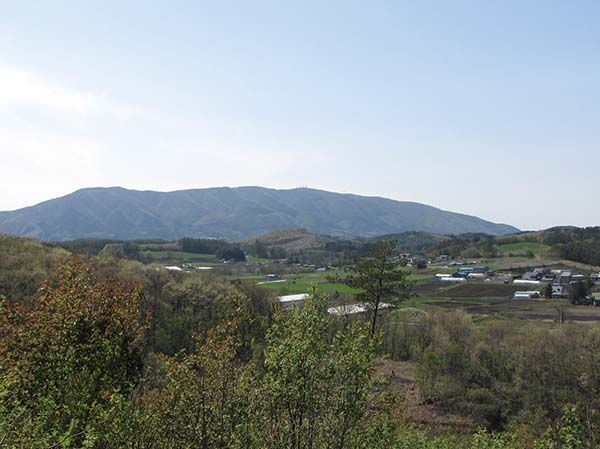Bulletin of the Geological Survey of Japan Top Page
Bulletin of the Geological Survey of Japan Vol.67 No.3 (2016)
Cover photograph | Table of Contents | Abstract
Cover photograph
Mt. Oritsume-dake in the Ichinohe–Kunohe area
Jurassic accretionary complexes consisting of basalt, limestone, chert, mudstone, sandstone, etc. are widely exposed in the region called the North Kitakami Belt. In the Ichinohe–Kunohe area (northeastern Iwate Prefecture), located in its northern part, they are stratigraphically divided into four formations: the Takayashiki, Seki, Kassenba and Kuzumaki in ascending order. Mt. Oritsume-dake in the back of the photo, whose ridge runs from north to south, consists of pelitic mixed rock facies including blocks of basalt, limestone, chert and sandstone (Kuzumaki Formation). In contrast, the peneplain in the front with flat-topped low mountains is underlain by coherent rock facies of chert, mudstone and sandstone (Seki and Kassenba formations). Their geological age differs significantly as well as their lithological features: the Kuzumaki Formation ranges from Toarcian age to Bathonian age (Early to Middle Jurassic), while the Seki and Kassenba formations are assigned to Oxfordian–Kimmeridgian age and Kimmeridgian age (Late Jurassic), respectively.
(Photograph and Caption by Satoshi Nakae)
Table of Contents
All the pages PDF : 67_03_full.pdf [6.6MB]
| Title | Author | |
|---|---|---|
| Article | ||
| Sedimentation rate and sedimentary environment during the past 100 years in Lake Biwa, Shiga Prefecture, central Japan |
Yutaka Kanai and Yoshio Inouchi (p67-80)
|
67_03_01.pdf [4.7MB] |
| Report | ||
| Jurassic radiolarians from the Ichinohe–Kunohe area (Iwate Prefecture) in the North Kitakami Belt, Japan |
Satoshi Nakae (p81-100)
|
67_03_02.pdf [5.7MB] |
Abstract
Sedimentation rate and sedimentary environment during the past 100 years in Lake Biwa, Shiga Prefecture, central Japan
Yutaka Kanai and Yoshio Inouchi
Two core samples were taken from the northern basin of Lake Biwa in 2001 and 2014, and their sedimentation rates were determined using Pb-210 and Cs-137 methods. One of the sampling locations is off Imazu, near the deepest bottom of the lake and the other is off Takashima, shallower bottom like top of saddle. The average sedimentation rates were about 0.1 g / cm2/ y (0.1 – 0.3 cm / y), which are within the range of conventional reports, although that of the former was a little higher than that of the latter. As for the core taken near the deepest bottom of the lake, much sediment with excess Pb-210 deposited before 1960s, suggesting that they were supplied by flood and turbidity current. They are assumed to be caused by the seismic turbidites in 1981 and 1963 and the heavy rains and floods in1896, 1917, 1950s and 1960s.
On the other hand, surface sediment of the core taken at off Takashima showed the variation of water content and Pb-210 concentration, which are ascribed to the disturbance and mixing by surface biota and / or human activities.
Jurassic radiolarians from the Ichinohe–Kunohe area (Iwate Prefecture) in the North Kitakami Belt, Japan
Satoshi Nakae
The North Kitakami Belt in Northeast Japan, occupying a northeastern region of Iwate Prefecture, is chiefly underlain by a sedimentary complex consisting of various rock-types such as basalt, limestone, chert, mudstone and sandstone. These rocks in the studied Ichinohe–Kunohe area in the North Kitakami Belt were explored for their radiolarian content and seven mudstone samples yielded poorly-preserved radiolarian faunas with a dominance of Nassellaria over Spumellaria, as a result. The description and faunal analysis of these radiolarians revealed that the mudstone in this area indicates a long range in age from the Toarcian to the Kimmeridgian.
Geological Survey of Japan, AIST
- About GSJ
- Our Activities
- Purchase guide
-
Publications and Database
- information
- Bulletin of the Geological Survey of Japan
- bull2025(Vol.76)
- bull2024(Vol.75)
- bull2023(Vol.74)
- bull2022(Vol.73)
- bull2021(Vol.72)
- bull2020(Vol.71)
- bull2019(Vol.70)
- bull2018(Vol.69)
- bull2017(Vol.68)
- bull2016(Vol.67)
- bull2015(Vol.66)
- bull2014(Vol.65)
- bull2013(Vol.64)
- bull2012(Vol.63)
- bull2011(Vol.62)
- bull2010(Vol.61)
- bull2009(Vol.60)
- bull2008(Vol.59)
- bull2007(Vol.58)
- bull2006(Vol.57)
- bull2005(Vol.56)
- bull2004(Vol.55)
- bull2003(Vol.54)
- bull2002(Vol.53)
- bull2001(Vol.52)
- Bulletin of the Geological Survey of Japan(old)
- Annual Report on Active Fault and Paleoearthquake Researches
- Reports, Geological Survey of Japan
- CCOP-GSJ Groundwater Project Report
- CCOP Technical Bulletin
- Cruise Report
- Geological Hazards
- Learning and Education
- GSJ Database Collection
- Collection of links


